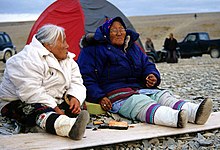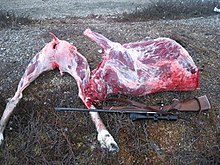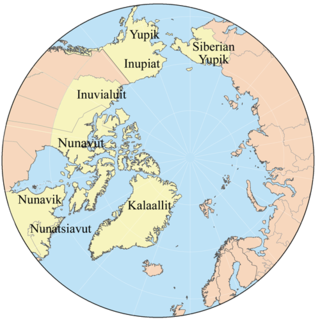
Eskimo is an exonym that refers to two closely related Indigenous peoples: Inuit and the Yupik of eastern Siberia and Alaska. A related third group, the Aleut, who inhabit the Aleutian Islands, are generally excluded from the definition of Eskimo. The three groups share a relatively recent common ancestor, and speak related languages belonging to the Eskaleut language family.

Blubber is a thick layer of vascularized adipose tissue under the skin of all cetaceans, pinnipeds, penguins, and sirenians. It was present in many marine reptiles, such as ichthyosaurs and plesiosaurs.

The Iñupiat are a group of Indigenous Alaskans whose traditional territory roughly spans northeast from Norton Sound on the Bering Sea to the northernmost part of the Canada–United States border. Their current communities include 34 villages across Iñupiat Nunaat, including seven Alaskan villages in the North Slope Borough, affiliated with the Arctic Slope Regional Corporation; eleven villages in Northwest Arctic Borough; and sixteen villages affiliated with the Bering Straits Regional Corporation. They often claim to be the first people of the Kauwerak.
The Thule or proto-Inuit were the ancestors of all modern Inuit. They developed in coastal Alaska by the year 1000 and expanded eastward across northern Canada, reaching Greenland by the 13th century. In the process, they replaced people of the earlier Dorset culture that had previously inhabited the region. The appellation "Thule" originates from the location of Thule in northwest Greenland, facing Canada, where the archaeological remains of the people were first found at Comer's Midden.

Vilhjalmur Stefansson was an Arctic explorer and ethnologist. He was born in Manitoba, Canada.
The culture of Greenland has much in common with Greenlandic Inuit tradition, as the majority of people are descended from Inuit. Many people still go ice fishing and there are annual dog-sled races in which everyone with a team participates.

Prehistoric Alaska begins with Paleolithic people moving into northwestern North America sometime between 40,000 and 15,000 years ago across the Bering Land Bridge in western Alaska; a date less than 20,000 years ago is most likely. They found their passage blocked by a huge sheet of ice until a temporary recession in the Wisconsin glaciation opened up an ice-free corridor through northwestern Canada, possibly allowing bands to fan out throughout the rest of the continent. Eventually, Alaska became populated by the Inuit and a variety of Native American groups. Trade with both Asia and southern tribes was active even before the advent of Europeans.

The toggling harpoon is an ancient weapon and tool used in whaling to impale a whale when thrown. Unlike earlier harpoon versions which had only one point, a toggling harpoon has a two-part point. One half of the point is firmly attached to the thrusting base, while the other half of the point is fitted over this first point like a cap and attached to the rest of the point with sinew or another string-like material. When the harpoon is thrust into an animal, the top half of the point detaches and twists horizontally into the animal under the skin, allowing hunters to haul the animal to ship or shore. This harpoon technology lodges the toggling head of the harpoon underneath both the animal's skin and blubber, and instead lodges the point in the muscle, which also prevents the harpoon slipping out.

Protein poisoning is an acute form of malnutrition caused by a diet deficient in fat and carbohydrates, where almost all bioavailable calories come from the protein in lean meat. The concept is discussed in the context of paleoanthropological investigations into the diet of ancient humans, especially during the Last Glacial Maximum and at high latitude regions.

Muktuk is a traditional food of the peoples of the Arctic, consisting of whale skin and blubber. It is most often made from the bowhead whale, although the beluga and the narwhal are also used. It is usually consumed raw, but can also be eaten frozen, cooked, or pickled.
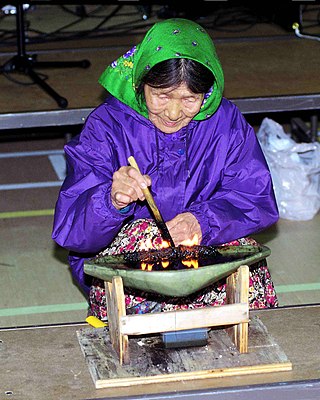
The Inuit are an indigenous people of the Arctic and subarctic regions of North America. The ancestors of the present-day Inuit are culturally related to Iñupiat, and Yupik, and the Aleut who live in the Aleutian Islands of Siberia and Alaska. The term culture of the Inuit, therefore, refers primarily to these areas; however, parallels to other Eskimo groups can also be drawn.
Nuliajuk is a goddess of the Netsilik Inuit. According to Rasmussen Nuliajuk lives on the bottom of the sea and controls sea mammals. Whenever humans neglect to observe ritual prohibitions, she imprisons the sea-mammals within the drip-basin under her lamp, so that shamans must conjure her so as to release them. Nuliajuk is co-wife with Isarraitaitsoq; their husband is the scorpionfish god Kanajuk. They have an adopted baby, which they stole "from a sleeping mother when her husband was out hunting at the breathing holes".

Greenlandic cuisine is traditionally based on meat from marine mammals, birds, and fish, and normally contains high levels of protein. Since colonization and the arrival of international trade, the cuisine has been increasingly influenced by Danish, British, American and Canadian cuisine. During the summer when the weather is milder, meals are often eaten outdoors.
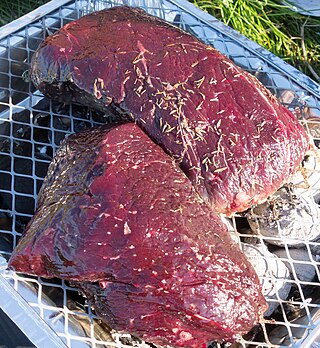
Whale meat, broadly speaking, may include all cetaceans and all parts of the animal: muscle (meat), organs (offal), skin (muktuk), and fat (blubber). There is relatively little demand for whale meat, compared to farmed livestock. Commercial whaling, which has faced opposition for decades, continues today in very few countries, despite whale meat being eaten across Western Europe and colonial America previously. However, in areas where dolphin drive hunting and aboriginal whaling exist, marine mammals are eaten locally as part of a subsistence economy: the Faroe Islands, the circumpolar Arctic, other indigenous peoples of the United States, St. Vincent and the Grenadines, some of villages in Indonesia and in certain South Pacific islands.

The Greenlandic Inuit are the indigenous and most populous ethnic group in Greenland. Most speak Greenlandic and consider themselves ethnically Greenlandic. People of Greenland are citizens of Denmark.

The Inuit are indigenous people who live in the Arctic and subarctic regions of North America. The ancestors of the present-day Inuit are culturally related to Iñupiat and Yupik, and the Aleut, who live in the Aleutian Islands of Siberia and Alaska. The word "Eskimo" has been used to encompass the Inuit and Yupik, and other indigenous Alaskan and Siberian peoples, but this usage is in decline.

Marine mammals are a food source in many countries around the world. Historically, they were hunted by coastal people, and in the case of aboriginal whaling, still are. This sort of subsistence hunting was on a small scale and produced only localised effects. Dolphin drive hunting continues in this vein, from the South Pacific to the North Atlantic. The commercial whaling industry and the maritime fur trade, which had devastating effects on marine mammal populations, did not focus on the animals as food, but for other resources, namely whale oil and seal fur.

Subsistence hunting of the bowhead whale is permitted by the International Whaling Commission, under limited conditions. While whaling is banned in most parts of the world, some of the Native peoples of North America, including the Eskimo and Iñupiat peoples in Alaska, continue to hunt the Bowhead whale. Aboriginal whaling is valued for its contribution to food stocks and to cultural survival, although the days of commercial whaling in the United States and in Canada are over.

Yup'ik cuisine refers to the Eskimo style traditional subsistence food and cuisine of the Yup'ik people from the western and southwestern Alaska. Also known as Cup'ik cuisine for the Chevak Cup'ik dialect speaking Eskimos of Chevak and Cup'ig cuisine for the Nunivak Cup'ig dialect speaking Eskimos of Nunivak Island. This cuisine is traditionally based on meat from fish, birds, sea and land mammals, and normally contains high levels of protein. Subsistence foods are generally considered by many to be nutritionally superior superfoods. Yup’ik diet is different from Alaskan Inupiat, Canadian Inuit, and Greenlandic diets. Fish as food are primary food for Yup'ik Eskimos. Both food and fish called neqa in Yup'ik. Food preparation techniques are fermentation and cooking, also uncooked raw. Cooking methods are baking, roasting, barbecuing, frying, smoking, boiling, and steaming. Food preservation methods are mostly drying and less often frozen. Dried fish is usually eaten with seal oil. The ulu or fan-shaped knife used for cutting up fish, meat, food, and such.

Chukchi cuisine refers to subsistence foods and their methods of preparation used by the Chukchi people, one of the indigenous peoples of Siberia.
